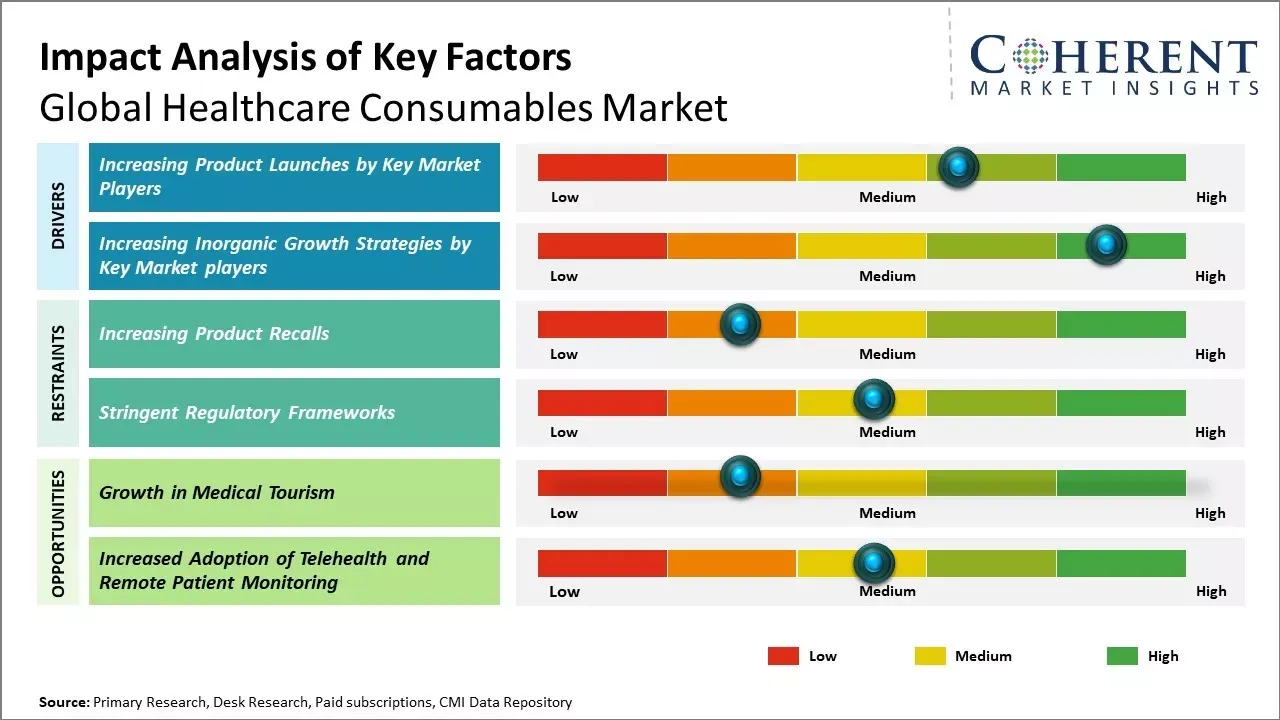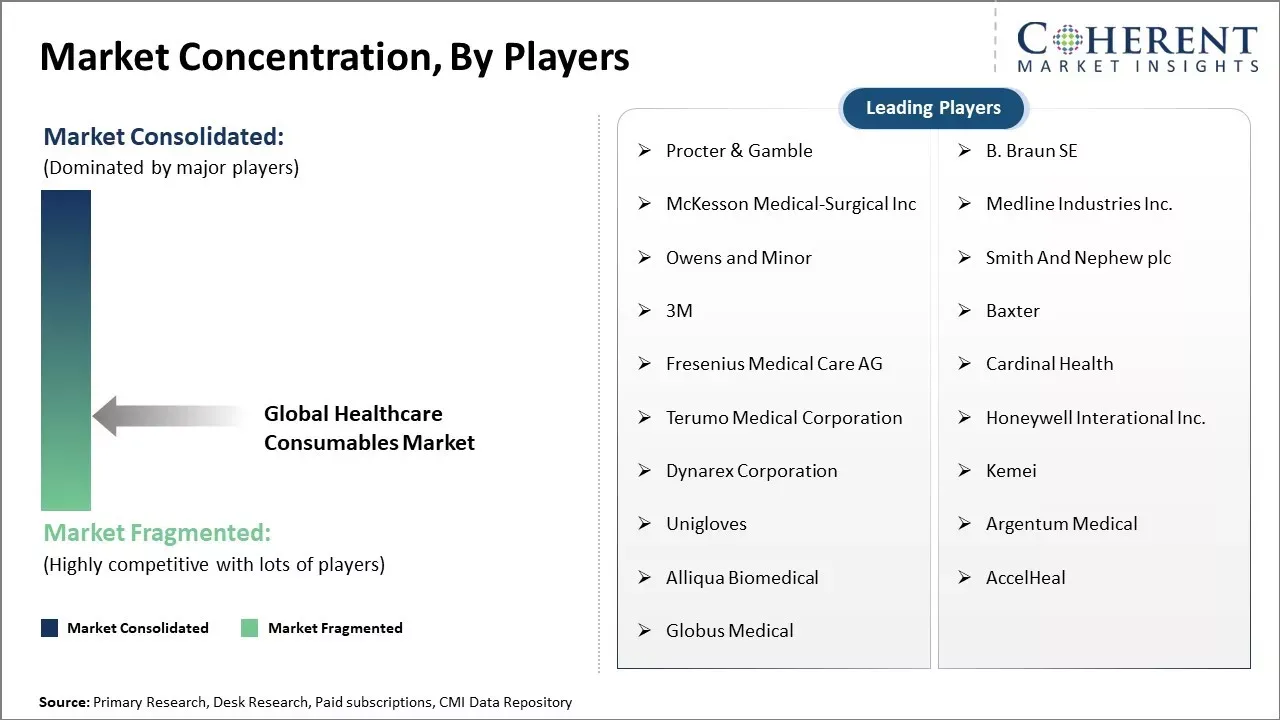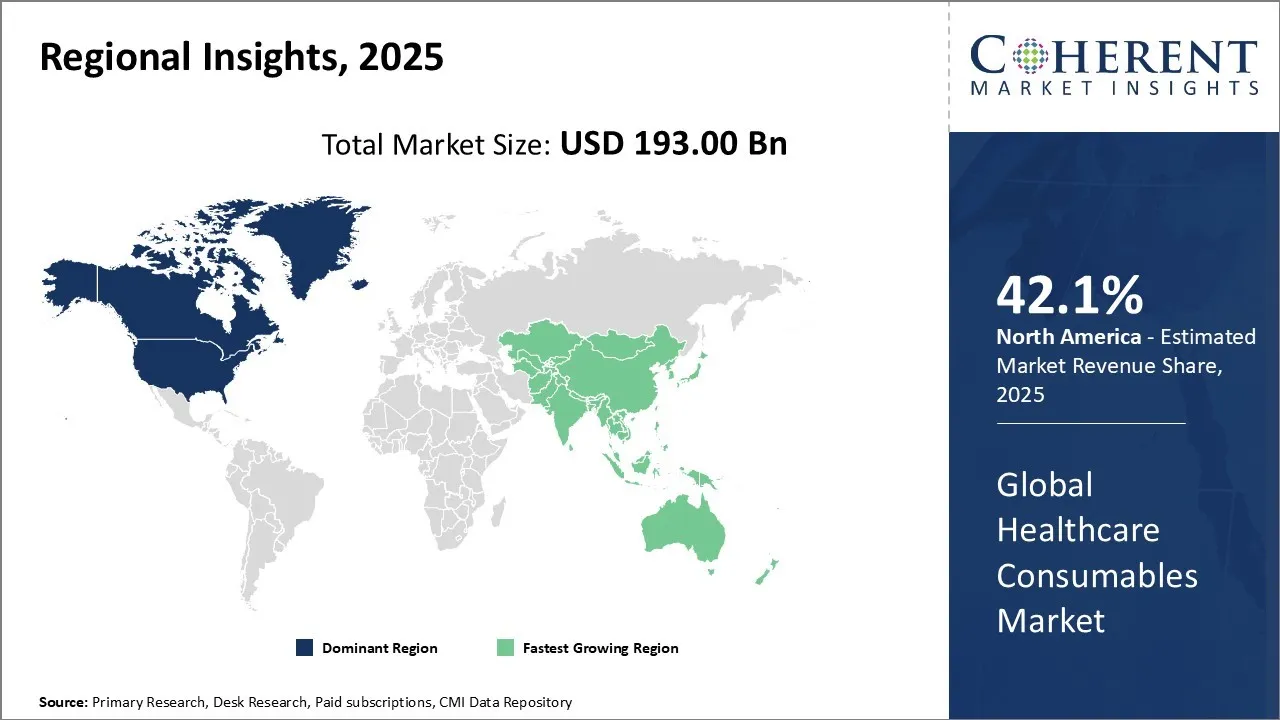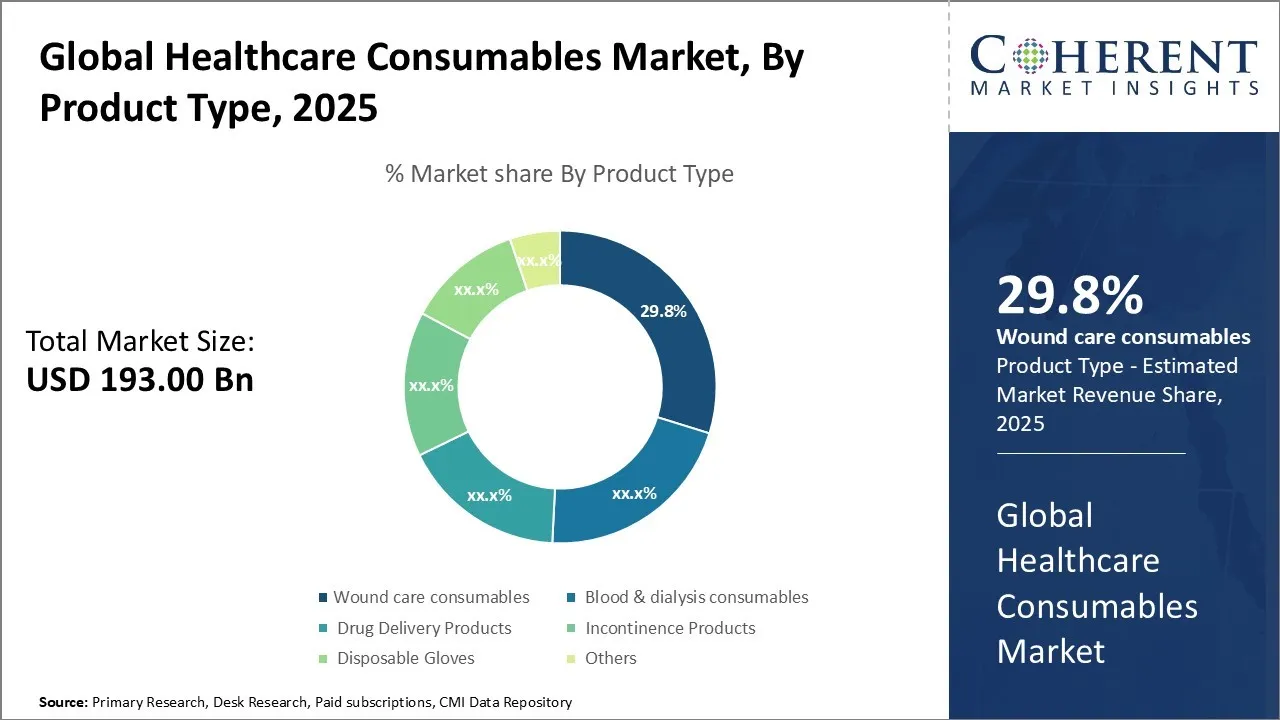Global Healthcare Consumables Market Analysis & Forecast - 2025 to 2032
Global healthcare consumables market is estimated to be valued at USD 193.00 Bn in 2025 and is expected to reach USD 426.94 Bn by 2032, exhibiting a compound annual growth rate (CAGR) of 12% from 2025 to 2032.

To learn more about this report, Download Free Sample
Key Takeaways
- By Product Type, wound care consumables are expected to capture the largest share of the healthcare consumables market in 2025, holding approximately 29.8%, driven by growing demand for advanced wound management solutions.
- By Raw Material, rubber-based consumables are projected to dominate with a 27.4% market share in 2025, reflecting widespread use in products such as gloves and tubing due to their flexibility and safety features.
- By End User, hospitals will remain the primary consumers of healthcare consumables, accounting for an estimated 32.9% share in 2025, supported by high procedural volumes and stringent infection control protocols.
- By Region, North America is set to maintain its leadership position with a 42.1% share of the global healthcare consumables market in 2025, underpinned by advanced healthcare infrastructure and substantial healthcare expenditure.
Market Overview
Global Healthcare Consumables Market is expected to witness steady growth due to increasing geriatric population worldwide and rising incidence of chronic as well as infectious diseases. Growing demand for better healthcare services coupled with technological advancements in healthcare infrastructure and consumables can drive the market growth in the near future. Rising medical tourism and increased healthcare spending is also expected to drive the market growth.
Current Events and Its Impact on Global Healthcare Consumables Market
|
Event |
Description and Impact |
|
Post-COVID-19 Healthcare Infrastructure Evolution |
|
|
Geopolitical Tensions and Trade Disruptions |
|
|
Technological Advancement and Digital Health Integration |
|
Uncover macros and micros vetted on 75+ parameters: Get instant access to report
Market Concentration and Competitive Landscape

To learn more about this report, Download Free Sample
Global Healthcare Consumables Market Insights, By Product Type
Product Type segment is sub-segmented into wound care consumables, blood and dialysis consumables, drug delivery products, incontinence products, disposable gloves, others. Wound care consumables sub-segment is estimated to hold 29.8% of the market share in 2025, owing to the inherent convenience these offer for wound treatment. Disposable wound care products such as bandages, tapes and gauzes allow for one-time application and easy disposal, thus, preventing infection risks associated with reuse of materials. Their peel-and-stick usability and good absorption capacity makes wound cleaning and dressing simpler for both patients and clinicians. This has become increasingly important as more treatment shifts to home and outpatient settings. Growing prevalence of chronic wounds like pressure ulcers and diabetic foot ulcers boosts demand.
Global Healthcare Consumables Market Insights, By Raw Material
Raw Material segment is sub-segmented into rubber, glass, metals, plastic, others. Rubber sub-segment is estimated to hold 27.4% of the market share in 2025 owing to its ideal properties for medical devices and clinical use. Being durable yet flexible, rubber is widely used to manufacture gloves, tubes, stoppers and other items that require a good combination of strength and elasticity. Natural and synthetic rubbers effectively create protective barriers against liquids and particles, making them suitable for examination and surgical gloves. These also serve as cushioning materials in products like catheters, bulbs and connectors. Rubber's high tensile strength and resistance to wear and tear ensure product integrity through repetitive use. Its non-porous surface does not support microbial growth, protecting against infection.
Global Healthcare Consumables Market Insights, By End User
End User segment is sub-segmented into hospitals, home healthcare, others. Hospitals sub-segment is estimated to hold 32.9% of the market share in 2025, owing to their central function in healthcare delivery and management of complex cases and emergencies. High patient volumes and varied needs within hospitals induce steady procurement of disposable supplies for diagnostics, surgery and general treatment purposes. Intense care units like emergency, intensive care and operation theatres in particular are sizeable consumers. The infrastructure and technical capabilities of hospitals also make them suitable locations for costly procedures, which involve extensive use of consumables. With growing specialization, tertiary and multi-specialty hospitals house expanded services that maintain demand. Moreover, hospitals set procurement standards that tend to be followed by other end users.
Regional Insights

To learn more about this report, Download Free Sample
North America Healthcare Consumables Market Analysis and Trends
North America is set to lead the global healthcare consumables market, holding an estimated 42.1% market share in 2025. This dominant position is supported by the region’s well-established healthcare infrastructure and broad accessibility to advanced medical facilities. The United States and Canada serve as hubs for key industry players, driving innovation and rapid adoption of cutting-edge healthcare technologies. High healthcare spending, combined with a growing elderly population requiring ongoing medical care, fuels sustained demand for disposable healthcare consumables. Furthermore, favorable regulatory frameworks and strong intellectual property protections incentivize continuous product development and market expansion across the region.
Asia Pacific Healthcare Consumables Market Analysis and Trends
Asia Pacific is emerging as the fastest-growing regional market for healthcare consumables, propelled by significant healthcare investments and expanding medical tourism in countries like China, India, and South Korea. These markets are experiencing heightened medical awareness and improved healthcare accessibility, particularly through government policies aimed at universal health coverage. Despite a current reliance on imports, the region is rapidly enhancing local manufacturing capabilities, bolstered by improving industry standards and infrastructure development. Increasing urbanization, rising disposable incomes, and strengthened government initiatives are expanding access to healthcare consumables across both urban and rural populations.
Dominating Countries in the Healthcare Consumables Market
United States Healthcare Consumables Market Analysis and Trends
The United States remains the largest contributor within North America, supported by a mature healthcare system and extensive healthcare expenditure. Its advanced medical supply chains and technology adoption enable widespread utilization of healthcare consumables. Additionally, stringent regulatory oversight and a focus on patient safety drive demand for high-quality consumable products. The presence of numerous global healthcare companies headquartered in the U.S. further consolidates its market leadership.
China Healthcare Consumables Market Analysis and Trends
China is a critical growth engine in Asia Pacific, benefiting from substantial government reforms aimed at expanding healthcare access and boosting domestic manufacturing of consumables. The country’s large population and rising chronic disease prevalence create robust demand for medical disposables. Recent policies targeting import substitution and innovation incentives have attracted foreign direct investment and accelerated the development of local production capabilities. This dual approach is positioning China as a major player in the global healthcare consumables supply chain.
India Healthcare Consumables Market Analysis and Trends
India’s healthcare consumables market is rapidly expanding, driven by increasing healthcare infrastructure investments and a growing emphasis on affordable healthcare solutions. The government’s push for universal healthcare and initiatives such as Make in India are strengthening local manufacturing. India benefits from a large skilled workforce and competitive production costs, making it an emerging export hub. Rising awareness of infection control and patient safety is further propelling domestic demand for disposable healthcare products.
Market Report Scope
Healthcare Consumables Market Report Coverage
| Report Coverage | Details | ||
|---|---|---|---|
| Base Year: | 2024 | Market Size in 2025: | USD 193.00 Bn |
| Historical Data for: | 2020 To 2024 | Forecast Period: | 2025 To 2032 |
| Forecast Period 2025 to 2032 CAGR: | 12% | 2032 Value Projection: | USD 426.94 Bn |
| Geographies covered: |
|
||
| Segments covered: |
|
||
| Companies covered: |
Procter & Gamble, B. Braun SE, McKesson Medical-Surgical Inc, Medline Industries Inc., Owens and Minor, Smith And Nephew plc, 3M, Baxter, Fresenius Medical Care AG, Cardinal Health, Terumo Medical Corporation, Honeywell Interational Inc., Dynarex Corporation, Kemei, Unigloves, Argentum Medical, Alliqua Biomedical, AccelHeal, Globus Medical |
||
| Growth Drivers: |
|
||
| Restraints & Challenges: |
|
||
Uncover macros and micros vetted on 75+ parameters: Get instant access to report
Healthcare Consumables Market Driver
Increasing Product Launches by Key Market Players
The Healthcare Consumables Market size is expanding rapidly due to increasing product launches by key market players. Companies are introducing innovative consumables like advanced wound care products, surgical disposables, and infection control items to meet rising healthcare demands. These launches enhance patient outcomes, drive competition, and fuel market growth across global healthcare systems.
Increasing Inorganic Growth Strategies by Key Market players
The Healthcare Consumables Market growth is expanding as key players pursue inorganic growth strategies like mergers, acquisitions, and strategic partnerships. These moves help companies broaden product portfolios, enter new markets, and enhance distribution networks. Such consolidation accelerates innovation, boosts competitiveness, and strengthens global presence in the rapidly evolving healthcare consumables landscape.
Healthcare Consumables Market Opportunity
Increased Adoption of Telehealth and Remote Patient Monitoring
Increased adoption of telehealth and remote patient monitoring offer opportunities for the global healthcare consumables market growth. Telehealth allows patients to connect with healthcare providers virtually through video calls, mobile apps, and web-based platforms. This enables remote monitoring of vital signs and simplified delivery of care without the need for in-person visits.
Analyst Viewpoint
- The global healthcare consumables market is experiencing strong and sustained growth, underpinned by a combination of demographic shifts and evolving healthcare demands. The rising incidence of chronic diseases alongside aging populations worldwide is driving continuous demand for disposable consumables in hospitals, outpatient clinics, and increasingly in home care settings. Enhanced healthcare spending and expanding medical insurance coverage in emerging markets are further accelerating market adoption and penetration.
- Advancements in medical technology and diagnostic devices are fueling innovation within the consumables segment, prompting greater adoption of specialized and premium products. In addition, heightened emphasis on infection prevention and patient safety, amplified by recent global health emergencies has significantly boosted the use of single-use supplies and personal protective equipment.
- Despite these positive drivers, the market faces challenges such as stringent regulatory requirements that can delay product approvals and increase compliance expenses. Environmental concerns about medical waste and growing sustainability mandates are compelling manufacturers to reconsider traditional disposable product designs. Moreover, healthcare providers’ focus on cost containment, combined with reimbursement constraints, exerts downward pressure on pricing and profitability.
- Regionally, North America retains its leadership position due to its advanced healthcare infrastructure, substantial healthcare expenditure, and robust regulatory environment. Meanwhile, the Asia-Pacific region stands out as the fastest-growing market, propelled by increased healthcare access, rising disposable incomes, and expanding medical tourism.
- Opportunities abound in developing biodegradable and eco-friendly consumables that address environmental challenges, expanding distribution into underserved rural areas, and integrating digital health technologies to optimize consumable usage. Additionally, the expanding home healthcare segment offers promising potential for tailored consumable products designed for patient self-care and remote monitoring applications.
Global Healthcare Consumables Market: Key Developments
- In April 2024, Teleflex Incorporated, a healthcare company, launched Wattson temporary pacing guidewire that have dual functionality to support valve delivery and ventricular bipolar during structural heart It can be used in transcatheter aortic valve replacement and balloon aortic valvuloplasty procedures.
- In October 2023, Braun SE, a medical device company, launched Introcan Safety 2 IV Catheter with Multi-Access Blood Control. The Introcan Safety 2 IV Catheter is the latest development from B. Braun in a long line of passive needlestick prevention catheters.
- In April 2023, Medline Industries Inc., a healthcare company, announced that it had entered a long-term prime vendor collaboration with DCH Health System (DCH) to address healthcare needs in the West Alabama region. The two organizations will work together to develop new strategies to improve patient outcomes and streamline supply chain processes.
Market Segmentation
- Product Type Insights (Revenue, USD Bn, 2025 - 2032)
- Wound care consumables
- Blood and dialysis consumables
- Drug Delivery Products
- Incontinence Products
- Disposable Gloves
- Others
- Raw Material Insights (Revenue, USD Bn, 2020 - 2032)
- Rubber
- Glass
- Metals
- Plastic
- Others
- End User Insights (Revenue, USD Bn, 2020 - 2032)
- Hospitals
- Home Healthcare
- Others
- Regional Insights (Revenue, USD Bn, 2020 - 2032)
- North America
- U.S.
- Canada
- Latin America
- Brazil
- Argentina
- Mexico
- Rest of Latin America
- Europe
- Germany
- U.K.
- Spain
- France
- Italy
- Russia
- Rest of Europe
- Asia Pacific
- China
- India
- Japan
- Australia
- South Korea
- ASEAN
- Rest of Asia Pacific
- Middle East
- GCC
- Israel
- Rest of Middle East
- Africa
- South Africa
- North Africa
- Central Africa
- Key Players Insights
- Procter & Gamble
- B. Braun SE
- McKesson Medical-Surgical Inc
- Medline Industries Inc.
- Owens and Minor
- Smith And Nephew plc
- 3M
- Baxter
- Fresenius Medical Care AG
- Cardinal Health
- Terumo Medical Corporation
- Honeywell Interational Inc.
- Dynarex Corporation
- Kemei
- Unigloves
- Argentum Medical
- Alliqua Biomedical
- AccelHeal
- Globus Medical
Sources
Primary Research Interviews
- Medical Device Manufacturers
- Healthcare Facility Procurement Managers
- Distributors and Suppliers
- Healthcare Professionals (Nurses, Technicians)
- Others
Databases
- WHO Global Health Observatory
- FDA Medical Device Database
- Eurostat Health Statistics
- National Health Service (NHS) Data
- Others
Magazines
- Medical Device & Diagnostic Industry (MD+DI)
- Healthcare Purchasing News
- Materials Management in Health Care
- Medical Economics
- Others
Journals
- Journal of Medical Devices
- American Journal of Infection Control
- Healthcare Management Forum
- Others
Newspapers
- Financial Times Healthcare Section
- Healthcare Finance News
- Modern Healthcare
- Fierce Healthcare
- Others
Associations
- Advanced Medical Technology Association (AdvaMed)
- Healthcare Financial Management Association (HFMA)
- International Association for Healthcare Central Service Material Management (IAHCSMM)
- Medical Device Manufacturers Association (MDMA)
- Others
Public Domain Sources
- Centers for Disease Control and Prevention (CDC)
- World Health Organization (WHO) Publications
- U.S. Department of Health and Human Services
- European Centre for Disease Prevention and Control (ECDC)
- Others
Proprietary Elements
- CMI Data Analytics Tool
- Proprietary CMI Existing Repository of information for last 8 years
*Definition: Healthcare Consumables consists of medical supplies that are designed for one-time or limited use in healthcare facilities like hospitals, clinics, and other medical institutions. This includes products like syringes, catheters, bandages, surgical gowns, gloves, drapes, and other disposable items that are used on patients. Healthcare consumables are essential for providing medical treatment and protecting both patients and healthcare workers from infections.
Share
Share
About Author
Komal Dighe is a Management Consultant with over 8 years of experience in market research and consulting. She excels in managing and delivering high-quality insights and solutions in Health-tech Consulting reports. Her expertise encompasses conducting both primary and secondary research, effectively addressing client requirements, and excelling in market estimation and forecast. Her comprehensive approach ensures that clients receive thorough and accurate analyses, enabling them to make informed decisions and capitalize on market opportunities.
Missing comfort of reading report in your local language? Find your preferred language :
Transform your Strategy with Exclusive Trending Reports :
Frequently Asked Questions
EXISTING CLIENTELE
Joining thousands of companies around the world committed to making the Excellent Business Solutions.
View All Our Clients

